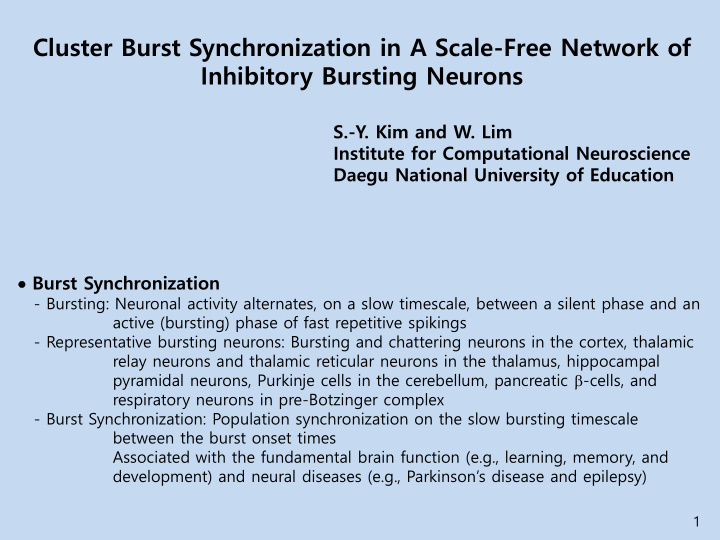



Cluster Burst Synchronization in A Scale-Free Network of Inhibitory Bursting Neurons S.-Y. Kim and W. Lim Institute for Computational Neuroscience Daegu National University of Education • Burst Synchronization - Bursting: Neuronal activity alternates, on a slow timescale, between a silent phase and an active (bursting) phase of fast repetitive spikings - Representative bursting neurons: Bursting and chattering neurons in the cortex, thalamic relay neurons and thalamic reticular neurons in the thalamus, hippocampal pyramidal neurons, Purkinje cells in the cerebellum, pancreatic -cells, and respiratory neurons in pre-Botzinger complex - Burst Synchronization: Population synchronization on the slow bursting timescale between the burst onset times Associated with the fundamental brain function (e.g., learning, memory, and development) and neural diseases (e.g., Parkinson’s disease and epilepsy) 1
Cluster Burst Synchronization • Cluster Synchronization - Cluster Synchronization: The whole population is segregated into synchronous sub- populations (called also as clusters) with phase lag among them. - Investigated experimentally, numerically, or theoretically in a variety of contexts in diverse coupled (physical, chemical, biological, and neural) oscillators; Josepson junction arrays, globally-coupled chemical oscillators, synthetic genetic networks, and globally- coupled networks of inhibitory (non-oscillatory) reticular thalamic nucleus neurons and other inhibitory model neurons • Scale-Free Network - Synaptic connectivity in neural networks: Complex topology which is neither regular nor completely random - Scale-Free Neural Network: Power-law degree distributions in the rat hippocampal networks and the human cortical functional network • Purpose of Our Study Investigation of Occurrence of Cluster Burst Synchronization in Inhibitory Scale- Free Network of Bursting Neurons 2
Inhibitory Scale-Free Network of Hindmarsh-Rose Bursting Neurons • Scale-Free Network of Suprathreshold Hindmarsh-Rose Neurons - Barabási -Albert scale-free network with symmetric attachment degree 𝑚 ∗ = 15 (Growth and preferential directed attachment with 𝑚 𝑗𝑜 incoming edges and 𝑚 𝑝𝑣𝑢 outgoing edges; 𝑚 𝑗𝑜 = 𝑚 𝑝𝑣𝑢 = 𝑚 ∗ ) - Suprathreshold Hindmarsh-Rose Neurons for the DC current 𝐽 𝐸𝐷,𝑗 ∈ [1.3, 1.4] - GABA A -mediated inhibitory synaptic currents with 𝜐 𝑚 = 1 , 𝜐 𝑠 = 0.5 , 𝜐 𝑒 = 5 , & 𝑌 𝑡𝑧𝑜 = −2 - Deterministic bursting for 𝐽 𝐸𝐷 = 1.35 ∗ = −1 ): Bursting threshold Horizontal dotted line ( 𝑦 𝑐 Solid circles: Bursting onset times • Emergence of Burst Synchronization ∗ ≃ 0.78 < 𝐾 < 𝐾 2 ∗ (≃ 537) Occurrence of Burst Synchronization in the range of 𝐾 𝑚 3
Emergence of 3-Cluster Burst Synchronization • Cluster Burst Synchronization - Appearance of bursting stripes in the raster plot of burst onset times in the whole population and small amplitude regular oscillations in instantaneous whole population burst rate 𝑆 𝑥 (𝑢) - Appearance of bursting stripes at every 3rd global cycle of 𝑆 𝑥 (𝑢) and regular oscillation in instantaneous sub-population burst rate 𝑆 𝑡 (𝐽) (𝑢) - With increasing 𝐾 0 , cluster burst synchronization gets better. • Localized Interburst Interval Single peak at 3𝑈 𝐷 ( 𝑈 𝐷 : cluster period & same with global period 𝑈 𝐻 of 𝑆 𝑥 ) in histogram Interburst interval: Localized in 2𝑈 𝐷 < 𝐽𝐶𝐽 < 4𝑈 𝐷 Maximum height for 𝐾 0 = 2 . Decrease and broader with increasing 𝐾 0 4
Break-up of 3 Clusters via Intercluster Hopping for 𝑲 𝟏 = 𝟐𝟏 • Break-up of Cluster Burst Synchronization - Delocalized interburst interval: Two peaks at 3𝑈 𝐻 & 4𝑈 𝐻 → Occurrence of burst skipping → Break-up of cluster bursting synchronization • Intercluster Hopping Initial stage Intermediate stage Final stage - Occurrence of intermittent intercluster hoppings from 𝐽 th cluster to the nearest neighboring (𝐽 + 1) th cluster in cyclic way due to burst skippings - Break-up of clusters Persistent of burst synchronization in the whole population → Non-cluster burst synchronization 5
Transition to Burst Synchronization to Desynchronization • Intensified Burst Skipping Distribution of interburst interval: Broaden with increasing 𝐾 0 Bursting stripes in the raster plot: more smeared Amplitude of instantaneous whole population burst rate: Decreased → With increasing 𝐾 0 , burst synchronization becomes more and more worse. Desynchronization: Broad single peak in the interburst interval histogram Completely scattered raster plot without forming any bursting stripes & nearly stationary instantaneous whole population burst rate 6
Summary • Cluster Burst Synchronization in Scale-Free Network of Burst Neurons - Occurrence of dynamical clustering in the scale-free network with no internal symmetry - Localization of interburst intervals in the region of 2𝑈 𝐷 < 𝐽𝐶𝐽 < 4𝑈 𝐷 ( 𝑈 𝐷 : cluster period) → Occurrence of 3 cluster burst synchronization • Break-up of Cluster Burst Synchronization - Occurrence of burst skipping and delocalization of interburst intervals - Intercluster hoppings from the 𝐽 th cluster to the 𝐽 + 1 th cluster due to burst skipping → Break-up of clusters 7
Recommend
More recommend